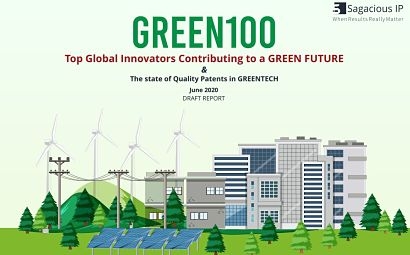
The report utilises Sagacious IP’s expertise in Intellectual Property (IP) analytics, notably its Sagacious Patent Portfolio Quality Mix (SPPQM) Methodology, to produce a Green 100 Ranking, evaluating organisations that are putting significant efforts to develop and protect Green Technologies. Sagacious IP looked into the IP these organisations have filed in order to assess and rank them in the report.
The organisations assessed in the report span a number of sectors, including telecommunications and electronics, vehicles and components, industrial machinery, energy and aviation.
According to Tarun Kumar Bansal, Sagacious IP President, many of the organisations featured in the report have already initiated R&D programmes focusing on green technology development.
“Intellectual property is one of the primary factors to evaluate the current inclination of global organisations towards a Green Future” Mr Bansal says in the report’s introduction. “Lifetime Green Patent Portfolio has increased 3.5 times in the last 20 years. The current Lifetime Green Patent Portfolio is approximately 2.5 million patent families with more than one-third patent families added in last 5 years only”.
The SPPQM Methodology assesses the organisations according to three components, which are:
Commitment to Green Future - Assesses the commitment each organisation is exhibiting for the Green future. The commitment is assessed based on investment they have made in research as depicted by their IP filings (Absolute Green Portfolio Size, Geographical Spread etc).
Current Impact on Green Future – This measures the current impact the patents are likely to have created towards a green future. This impact is adjudged broadly though the overall quality of their individual Green Patent Portfolio as well as number of industries/players impacted through their patented research.
Potential of Crafting the Green Future - Determines if an organisation is consistently contributing to the Green Future with a patent pipeline to lead the green future. This is evaluated based on their Green Patent Pipeline, future potential to exclude as well as future applicability of their patented research. It assesses the commitment each organisation is exhibiting for the Green future. This commitment is assessed based on investment the various organisations have made in research as depicted by their IP filings (Absolute Green Portfolio Size, Geographical Spread etc).
According to Bansal, one of the unique features of the SPPQM methodology is that it is not based on just quantity of patents owned by an organisation but significantly considers the quality of patents owned by the organisation. The primary intent of the study is to discover, benchmark, raise awareness and spark critical conversation around the quality of innovation being achieved in the domain of Green Technologies which Sagacious IP believes is critical for creating a Green Future.
The company’s aim is to motivate organisations to focus on quality over quantity to create a great impact and help achieve a green future at a faster pace.
For additional information:

